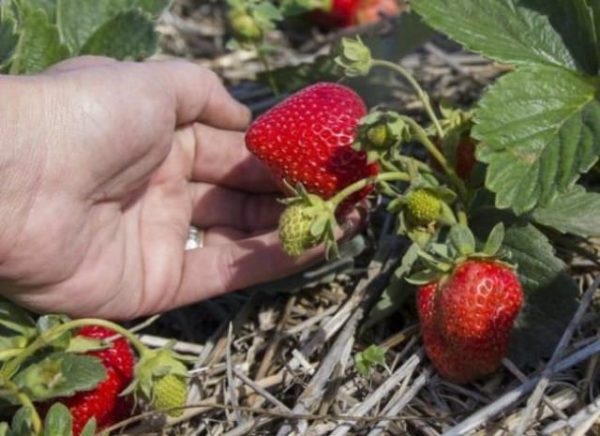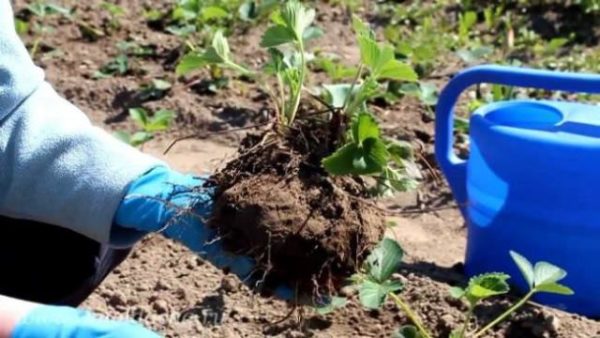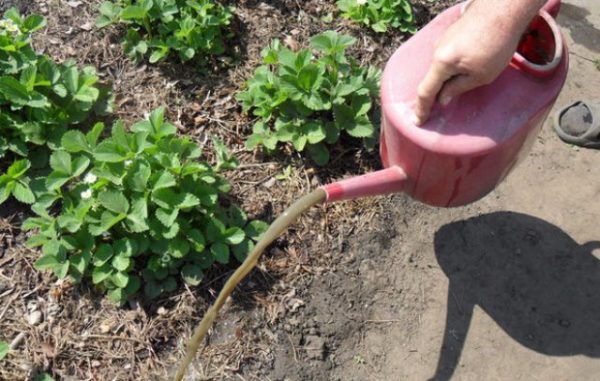Strawberry Eliana, and more correctly, strawberry Eliana, conquered gardeners with its impeccable taste and beautiful shape of berries. It is often positioned as a variety for private small farms, although in Europe it is cultivated on a large scale for sale. In this article we will talk about the description and planting strawberries Eliana.
Table of contents
Description strawberry varieties Eliana
Elianny large-fruited early strawberries were bred by Dutch breeders at the end of the 20th century.. The bush is powerful, strong. Flower stalks are located above the leaves. Ideal for cultivation in a continental climate.
According to gardeners, with a reliable shelter, it can winter in Karelia, but freezes in the Urals and Kamchatka. In the suburbs with a quality shelter endures the winter well, but in particularly harsh years it can slowly restore the vegetative mass.
From one bush per season, up to two kilograms of berries are collected, which are perfectly stored in the refrigerator for a long time.

By the end of spring, the berries ripen, and the fruiting period continues until early July. At one place the variety can be grown without a decrease in yield over the course of 8 years.
Characteristics of berries
The berries of this variety are large and fragrant., elongated conical shape with a small neck. Can reach weight up to 90 grams. The flesh is red, dense, juicy. Achenes yellow, protruding above the dense skin of the berries, so that it is not injured after collection. Berry is easily separated from the sepals.
The taste is multifaceted, sugary with a slightly sour and fruity aroma, smoothly turning into a pronounced strawberry.
Breeding history and region of growth
The correct name of the variety: Elianny (Eliana, Elianne).
Growing region: Netherlands, originator Elert Konings / Geobr. Vissers
Year of breeding: 1998

The advantages and disadvantages of the variety
The variety has indisputable advantages:
- Selfing;
- It has an early ripening period;
- Harmonious ripening of berries;
- High yield;
- Hardy;
- Lying down;
- Resistant to powdery mildew.
Among the disadvantages include:
- Not resistant to heat. In the southern regions and central Ukraine, as well as in central Russia, at high temperatures, the berry does not gain the optimal size, it can “zayumlivatsya."
- It hardly endures the harsh winters in northeastern Russia. Requires additional shelter.
- Sour taste can increase in rainy years.
Growing conditions
In the spring, all damaged and dried leaves are removed from the bushes.. In April, it is necessary to carry out the first top-dressing with nitrogen-containing fertilizer with the main elements.To prevent the development of fungal lesions, the soil around the bushes is treated with a 1% solution of Bordeaux mixture or colloidal sulfur.
A week before the start of flowering, it is necessary to treat the plantings with the “Inta-Vir” drug or with the “Trikhodermin” solution.

Watering from a watering can over the plant is possible only before the appearance of ovariesIn this case, the leaves are washed from the dust. As soon as the bush blooms, watering is done strictly under the root, preventing water from entering the flower and, subsequently, on the berry. By the time the berries are rolling, watering should be reduced.
Fertilizer infusion of mullein or grass green fertilizer carried out after watering throughout the growing season.
Strawberry beds must be regularly weeded out by weeding or the use of gericides and loosen the soil.
Breeding methods
Eliana breeds with a mustache, but it should be remembered that in the absence of additional watering during the hot period, new sockets are formed scarcely, and most often by the end of summer.

Planting seedlings
Strawberry Eliana grows well on any type of soil, but the higher the fertility rate of the soil, the greater the yield. For planting seedlings, light loamy or sandy soil with an acidity level of 5.0–6.5 pH will be ideal. The plot for planting is deeply dug up with the simultaneous introduction of organic matter at the rate of 5-6 kg per 1 m² and mineral fertilizers 30-35 g with an emphasis on potassium, calcium, phosphorus, manganese and iron. The beds are allowed to settle, after which they mark the rows of future plantings at a distance of 50-60 cm from each other, and between bushes at least 25 cm.
To lay a plantation for the future, it is better to use last year’s “mustache”. As practice shows, seedlings planted in April - May, take root much more efficiently than those planted in July. But waiting for the harvest in the same year is not worth it, you will only enjoy the taste of the berry next season.
About 50% of the whiskers planted in the heat of July, but this seedling will definitely have time to take root and lay flower buds, and in exactly one year the owners will be richly rewarded. Alternatively, the landing can be carried out in August - September. Depending on the weather conditions, the bushes will have time to plant flower buds, and the first modest harvest will be available next summer.
For planting select healthy bushes without spots and dark spots on the leaves. Also pay attention to the thickness of the horn, it must be at least 7 mm.
The bed can be immediately covered with a black film after planting to protect against weeds, making cuts on it for strawberry bushes.

Diseases and pests
Grade resistant to gray mold, powdery mildew and most viral diseases characteristic of strawberries.
Sometimes on the landings can be found ticks. They affect the foliage, the berries on such bushes will be small.After harvest, the bushes are treated with "Malophos".
"Karbofos" and "Aktara" also successfully cope with strawberry beetles, whiteflies and weevils.
Preparing varieties for winter
In autumn, the plants are inspected, removing old flower stalks and diseased, dried leaves, are fed with complex fertilizers. Before the onset of frosts, they re-mulch the soil, filling up the gaps between bushes.
Conclusion
Gardeners praised the value of the variety and note the good resistance to frost, the ability to maintain marketability during transport. "Eliana" is suitable for cultivation in personal plots and as a field crop for agricultural farms. But the most important quality of this variety is its taste.
